University Marketing: Luxury Consumption and Counterfeit Goods Review
VerifiedAdded on 2023/04/06
|7
|1168
|375
Report
AI Summary
This report presents a literature review focusing on the interplay between luxury consumption and the proliferation of counterfeit goods. It delves into the core issue of how consumers perceive and make decisions regarding genuine versus counterfeit products, considering factors like buying motives, value-based drivers, and the impact on brand equity. The review examines the challenges businesses face in managing the rise of counterfeit products and strategies to maintain brand loyalty. Evidence from various studies and researchers is presented to analyze consumer behavior, including cultural influences, price sensitivity, and brand awareness. The rationale emphasizes the need to understand consumer psychology and emotions, especially in differentiating between authentic and counterfeit products. The report also highlights the literature gap in understanding consumer behavior when counterfeit products closely resemble genuine ones. The work references several academic sources to support the arguments, and the study aims to provide insights into effective marketing strategies for luxury brands in the face of counterfeiting challenges.
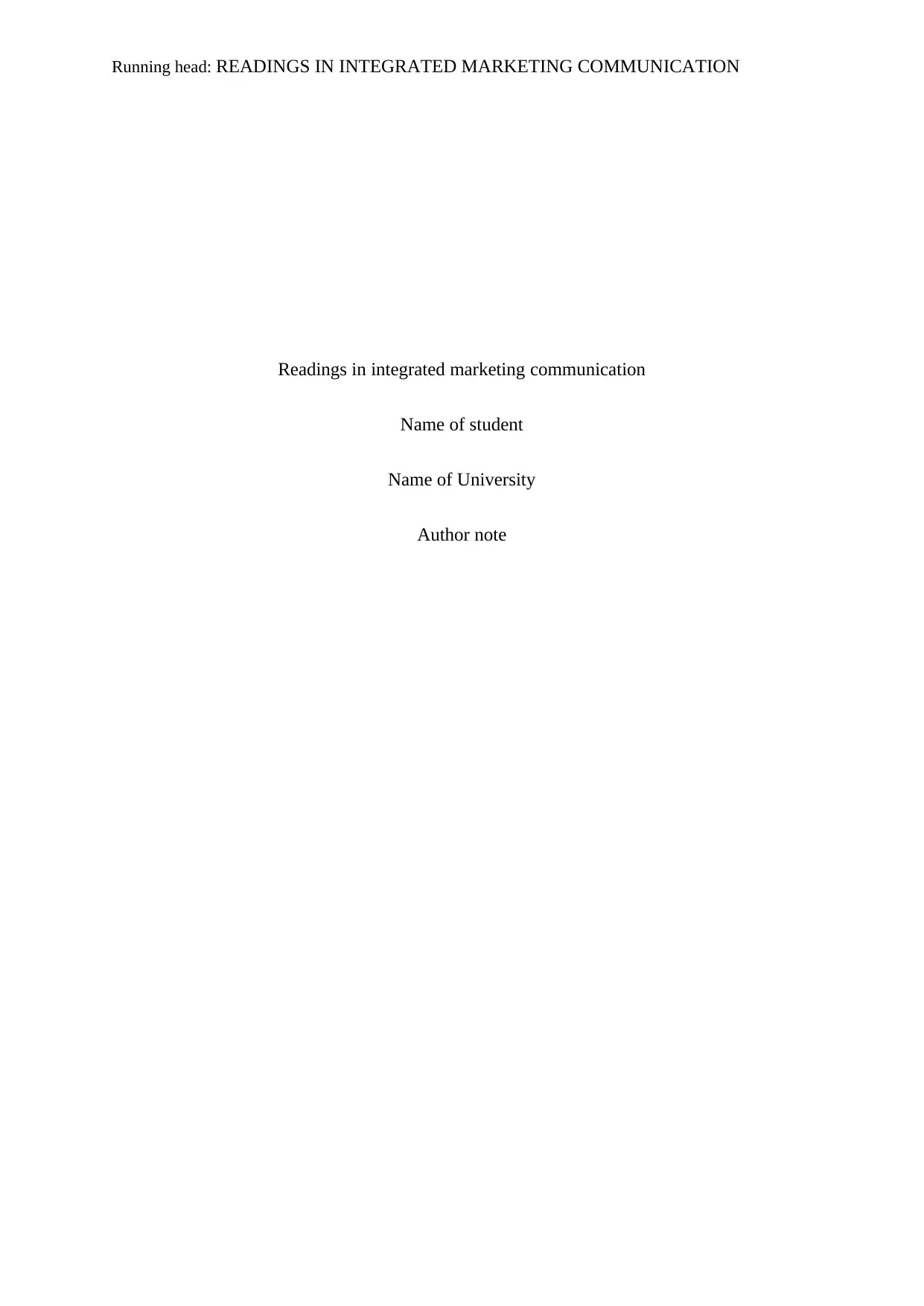
Running head: READINGS IN INTEGRATED MARKETING COMMUNICATION
Readings in integrated marketing communication
Name of student
Name of University
Author note
Readings in integrated marketing communication
Name of student
Name of University
Author note
Paraphrase This Document
Need a fresh take? Get an instant paraphrase of this document with our AI Paraphraser
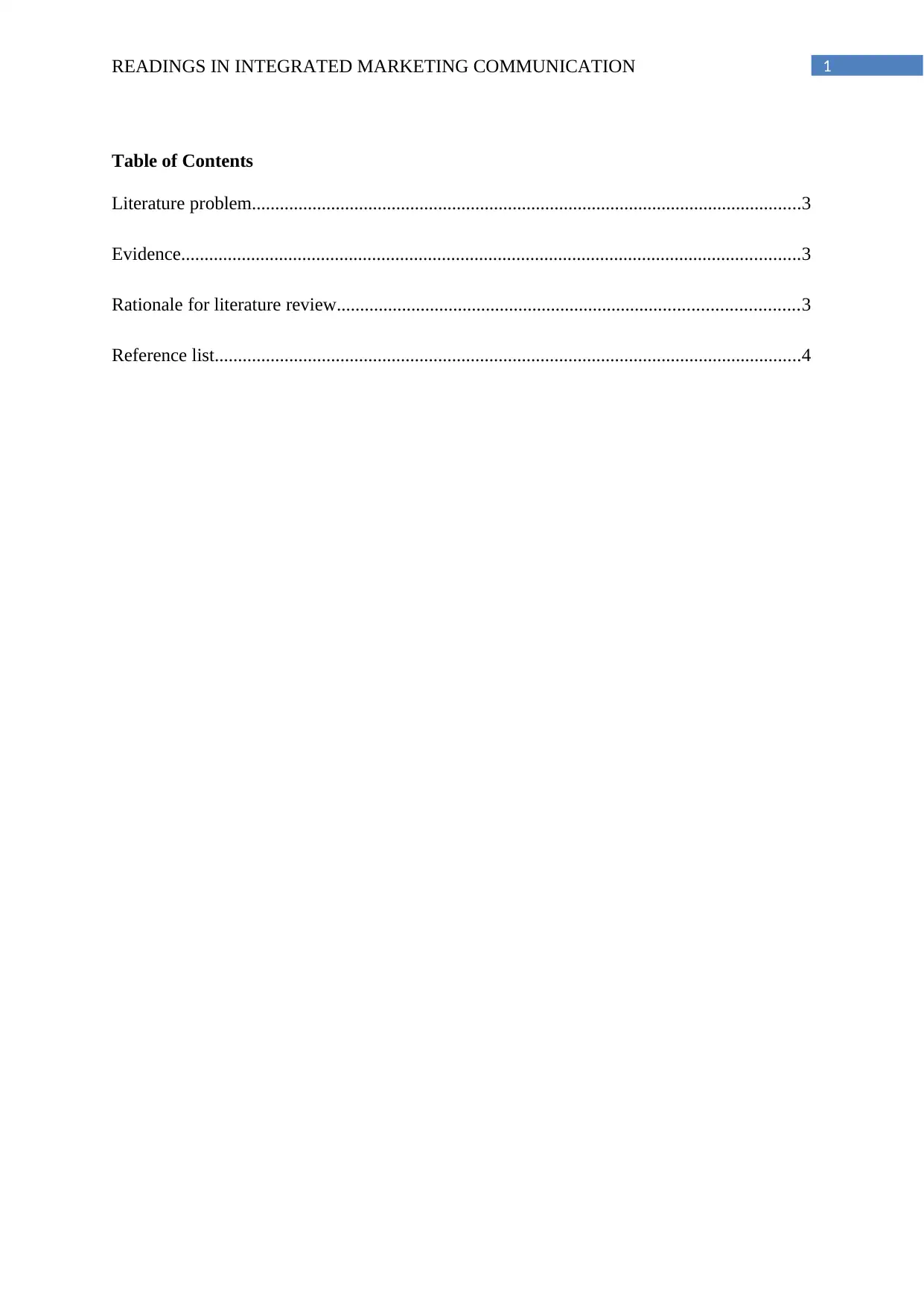
1READINGS IN INTEGRATED MARKETING COMMUNICATION
Table of Contents
Literature problem......................................................................................................................3
Evidence.....................................................................................................................................3
Rationale for literature review...................................................................................................3
Reference list..............................................................................................................................4
Table of Contents
Literature problem......................................................................................................................3
Evidence.....................................................................................................................................3
Rationale for literature review...................................................................................................3
Reference list..............................................................................................................................4
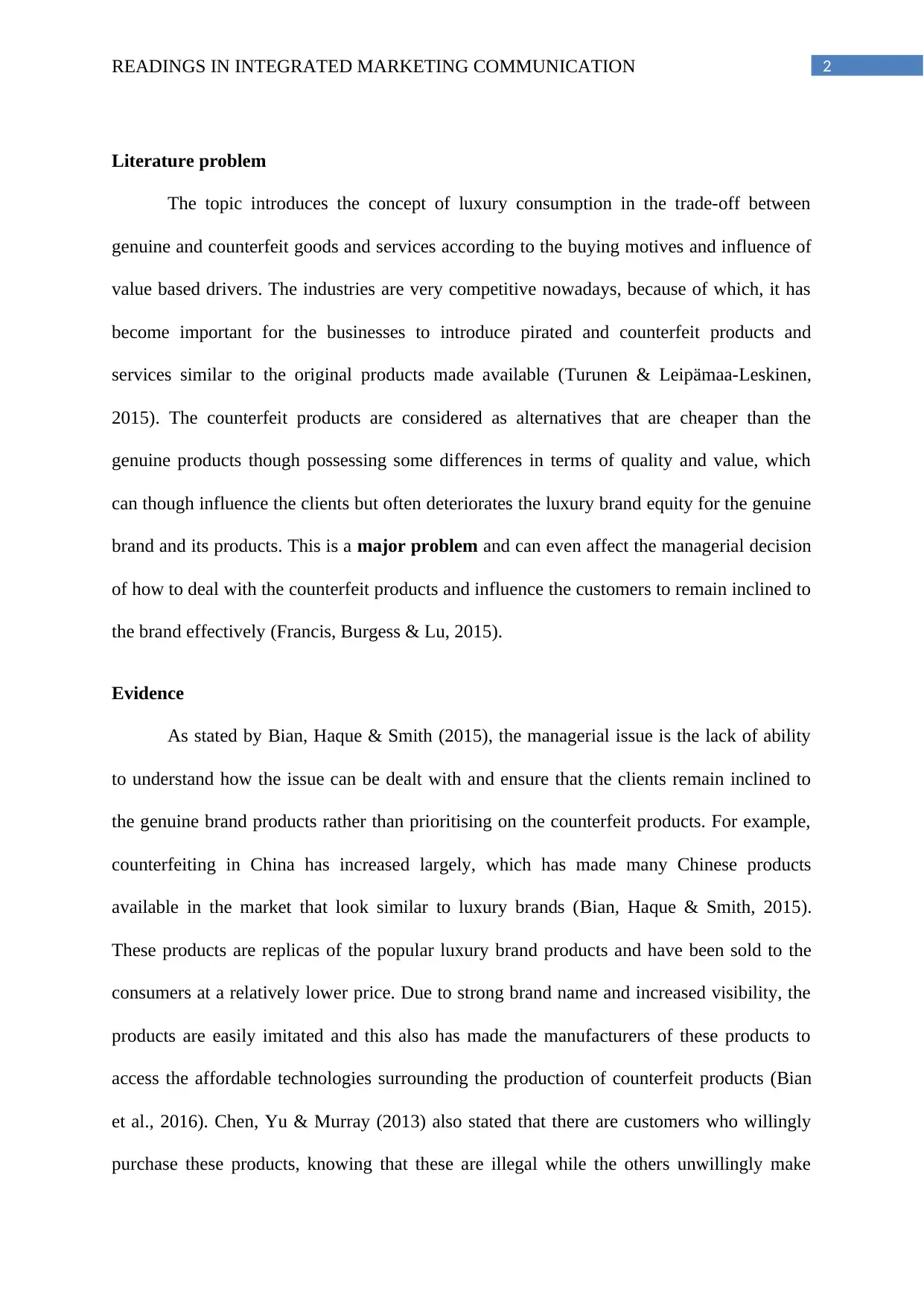
2READINGS IN INTEGRATED MARKETING COMMUNICATION
Literature problem
The topic introduces the concept of luxury consumption in the trade-off between
genuine and counterfeit goods and services according to the buying motives and influence of
value based drivers. The industries are very competitive nowadays, because of which, it has
become important for the businesses to introduce pirated and counterfeit products and
services similar to the original products made available (Turunen & Leipämaa-Leskinen,
2015). The counterfeit products are considered as alternatives that are cheaper than the
genuine products though possessing some differences in terms of quality and value, which
can though influence the clients but often deteriorates the luxury brand equity for the genuine
brand and its products. This is a major problem and can even affect the managerial decision
of how to deal with the counterfeit products and influence the customers to remain inclined to
the brand effectively (Francis, Burgess & Lu, 2015).
Evidence
As stated by Bian, Haque & Smith (2015), the managerial issue is the lack of ability
to understand how the issue can be dealt with and ensure that the clients remain inclined to
the genuine brand products rather than prioritising on the counterfeit products. For example,
counterfeiting in China has increased largely, which has made many Chinese products
available in the market that look similar to luxury brands (Bian, Haque & Smith, 2015).
These products are replicas of the popular luxury brand products and have been sold to the
consumers at a relatively lower price. Due to strong brand name and increased visibility, the
products are easily imitated and this also has made the manufacturers of these products to
access the affordable technologies surrounding the production of counterfeit products (Bian
et al., 2016). Chen, Yu & Murray (2013) also stated that there are customers who willingly
purchase these products, knowing that these are illegal while the others unwillingly make
Literature problem
The topic introduces the concept of luxury consumption in the trade-off between
genuine and counterfeit goods and services according to the buying motives and influence of
value based drivers. The industries are very competitive nowadays, because of which, it has
become important for the businesses to introduce pirated and counterfeit products and
services similar to the original products made available (Turunen & Leipämaa-Leskinen,
2015). The counterfeit products are considered as alternatives that are cheaper than the
genuine products though possessing some differences in terms of quality and value, which
can though influence the clients but often deteriorates the luxury brand equity for the genuine
brand and its products. This is a major problem and can even affect the managerial decision
of how to deal with the counterfeit products and influence the customers to remain inclined to
the brand effectively (Francis, Burgess & Lu, 2015).
Evidence
As stated by Bian, Haque & Smith (2015), the managerial issue is the lack of ability
to understand how the issue can be dealt with and ensure that the clients remain inclined to
the genuine brand products rather than prioritising on the counterfeit products. For example,
counterfeiting in China has increased largely, which has made many Chinese products
available in the market that look similar to luxury brands (Bian, Haque & Smith, 2015).
These products are replicas of the popular luxury brand products and have been sold to the
consumers at a relatively lower price. Due to strong brand name and increased visibility, the
products are easily imitated and this also has made the manufacturers of these products to
access the affordable technologies surrounding the production of counterfeit products (Bian
et al., 2016). Chen, Yu & Murray (2013) also stated that there are customers who willingly
purchase these products, knowing that these are illegal while the others unwillingly make
⊘ This is a preview!⊘
Do you want full access?
Subscribe today to unlock all pages.

Trusted by 1+ million students worldwide
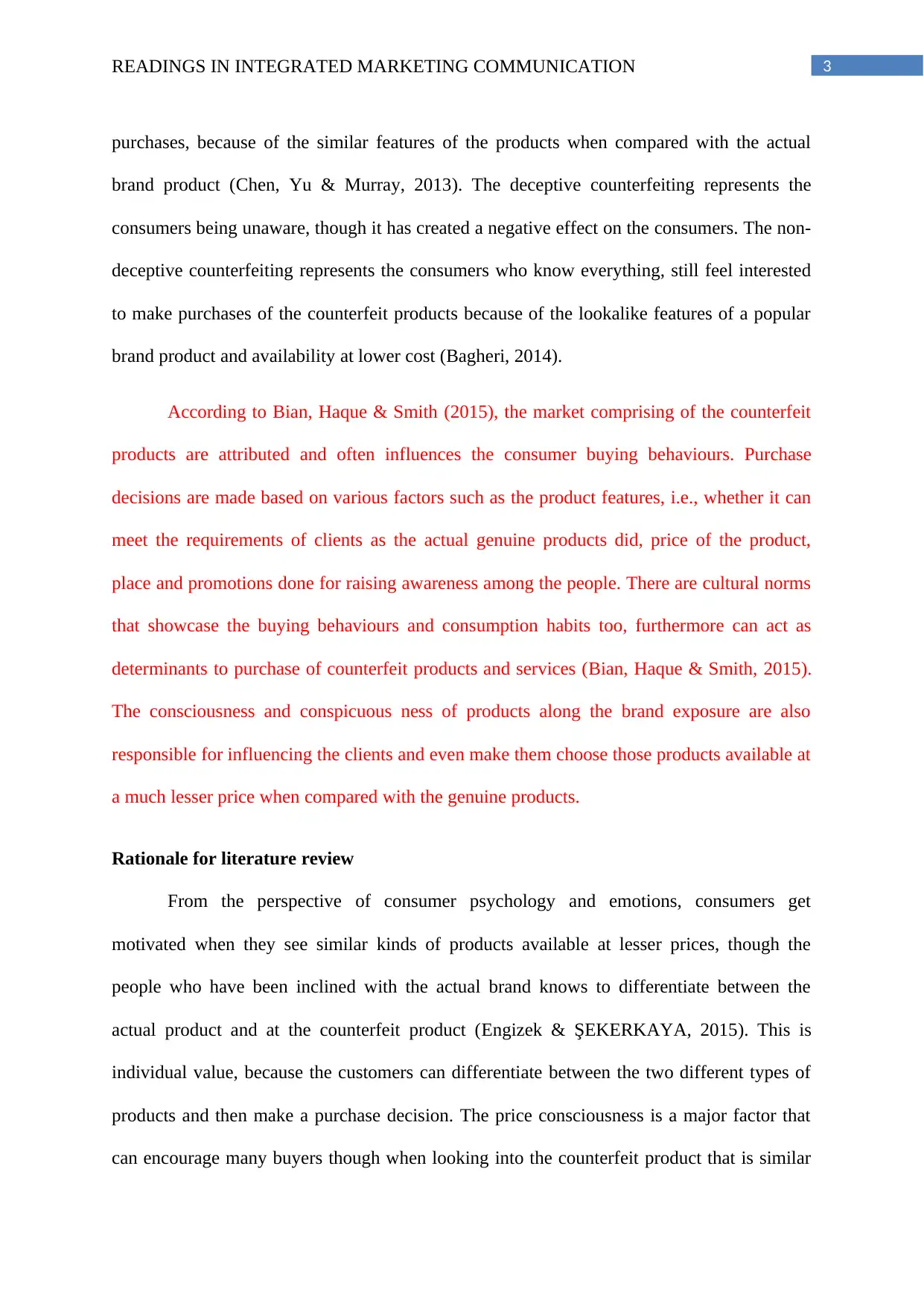
3READINGS IN INTEGRATED MARKETING COMMUNICATION
purchases, because of the similar features of the products when compared with the actual
brand product (Chen, Yu & Murray, 2013). The deceptive counterfeiting represents the
consumers being unaware, though it has created a negative effect on the consumers. The non-
deceptive counterfeiting represents the consumers who know everything, still feel interested
to make purchases of the counterfeit products because of the lookalike features of a popular
brand product and availability at lower cost (Bagheri, 2014).
According to Bian, Haque & Smith (2015), the market comprising of the counterfeit
products are attributed and often influences the consumer buying behaviours. Purchase
decisions are made based on various factors such as the product features, i.e., whether it can
meet the requirements of clients as the actual genuine products did, price of the product,
place and promotions done for raising awareness among the people. There are cultural norms
that showcase the buying behaviours and consumption habits too, furthermore can act as
determinants to purchase of counterfeit products and services (Bian, Haque & Smith, 2015).
The consciousness and conspicuous ness of products along the brand exposure are also
responsible for influencing the clients and even make them choose those products available at
a much lesser price when compared with the genuine products.
Rationale for literature review
From the perspective of consumer psychology and emotions, consumers get
motivated when they see similar kinds of products available at lesser prices, though the
people who have been inclined with the actual brand knows to differentiate between the
actual product and at the counterfeit product (Engizek & ŞEKERKAYA, 2015). This is
individual value, because the customers can differentiate between the two different types of
products and then make a purchase decision. The price consciousness is a major factor that
can encourage many buyers though when looking into the counterfeit product that is similar
purchases, because of the similar features of the products when compared with the actual
brand product (Chen, Yu & Murray, 2013). The deceptive counterfeiting represents the
consumers being unaware, though it has created a negative effect on the consumers. The non-
deceptive counterfeiting represents the consumers who know everything, still feel interested
to make purchases of the counterfeit products because of the lookalike features of a popular
brand product and availability at lower cost (Bagheri, 2014).
According to Bian, Haque & Smith (2015), the market comprising of the counterfeit
products are attributed and often influences the consumer buying behaviours. Purchase
decisions are made based on various factors such as the product features, i.e., whether it can
meet the requirements of clients as the actual genuine products did, price of the product,
place and promotions done for raising awareness among the people. There are cultural norms
that showcase the buying behaviours and consumption habits too, furthermore can act as
determinants to purchase of counterfeit products and services (Bian, Haque & Smith, 2015).
The consciousness and conspicuous ness of products along the brand exposure are also
responsible for influencing the clients and even make them choose those products available at
a much lesser price when compared with the genuine products.
Rationale for literature review
From the perspective of consumer psychology and emotions, consumers get
motivated when they see similar kinds of products available at lesser prices, though the
people who have been inclined with the actual brand knows to differentiate between the
actual product and at the counterfeit product (Engizek & ŞEKERKAYA, 2015). This is
individual value, because the customers can differentiate between the two different types of
products and then make a purchase decision. The price consciousness is a major factor that
can encourage many buyers though when looking into the counterfeit product that is similar
Paraphrase This Document
Need a fresh take? Get an instant paraphrase of this document with our AI Paraphraser

4READINGS IN INTEGRATED MARKETING COMMUNICATION
to the genuine product can make many buyers think that something is wrong. As stated by
Phau, Teah & Chuah (2015), loyalty towards the brand, perceived quality and awareness of
brand and its products are also major determinants that drive the consumers’ buying
behaviours (Phau, Teah & Chuah, 2015). This is mainly referred to as the functional value
that drives the consumers towards the product. In case cases, the loyal customers towards the
genuine brand products have considered it as unethical and not effective and thus there are
lesser chances of purchasing the counterfeits, while the high level of perceived quality for the
genuine products could make the consumers judge the quality of these counterfeit items in a
negative manner (Castaño & Eugenia Perez, 2014). Furthermore, with the word of mouth
promotions, other consumers will likely get influenced as well, which is considered as social
value. This would automatically make them unwilling to make purchases, furthermore ignore
these products.
The literature gap could be experienced when the consumers buying behaviours
should get influenced in case there are negligible differences in terms of features and quality
when the counterfeit products are compared with the genuine brand products (Rosenbaum,
Cheng & Wong, 2016). This might be a bit controversial, though it has been found that the
loyal customers have remained inclined with the brand and perceived quality and value while
making the purchases.
to the genuine product can make many buyers think that something is wrong. As stated by
Phau, Teah & Chuah (2015), loyalty towards the brand, perceived quality and awareness of
brand and its products are also major determinants that drive the consumers’ buying
behaviours (Phau, Teah & Chuah, 2015). This is mainly referred to as the functional value
that drives the consumers towards the product. In case cases, the loyal customers towards the
genuine brand products have considered it as unethical and not effective and thus there are
lesser chances of purchasing the counterfeits, while the high level of perceived quality for the
genuine products could make the consumers judge the quality of these counterfeit items in a
negative manner (Castaño & Eugenia Perez, 2014). Furthermore, with the word of mouth
promotions, other consumers will likely get influenced as well, which is considered as social
value. This would automatically make them unwilling to make purchases, furthermore ignore
these products.
The literature gap could be experienced when the consumers buying behaviours
should get influenced in case there are negligible differences in terms of features and quality
when the counterfeit products are compared with the genuine brand products (Rosenbaum,
Cheng & Wong, 2016). This might be a bit controversial, though it has been found that the
loyal customers have remained inclined with the brand and perceived quality and value while
making the purchases.
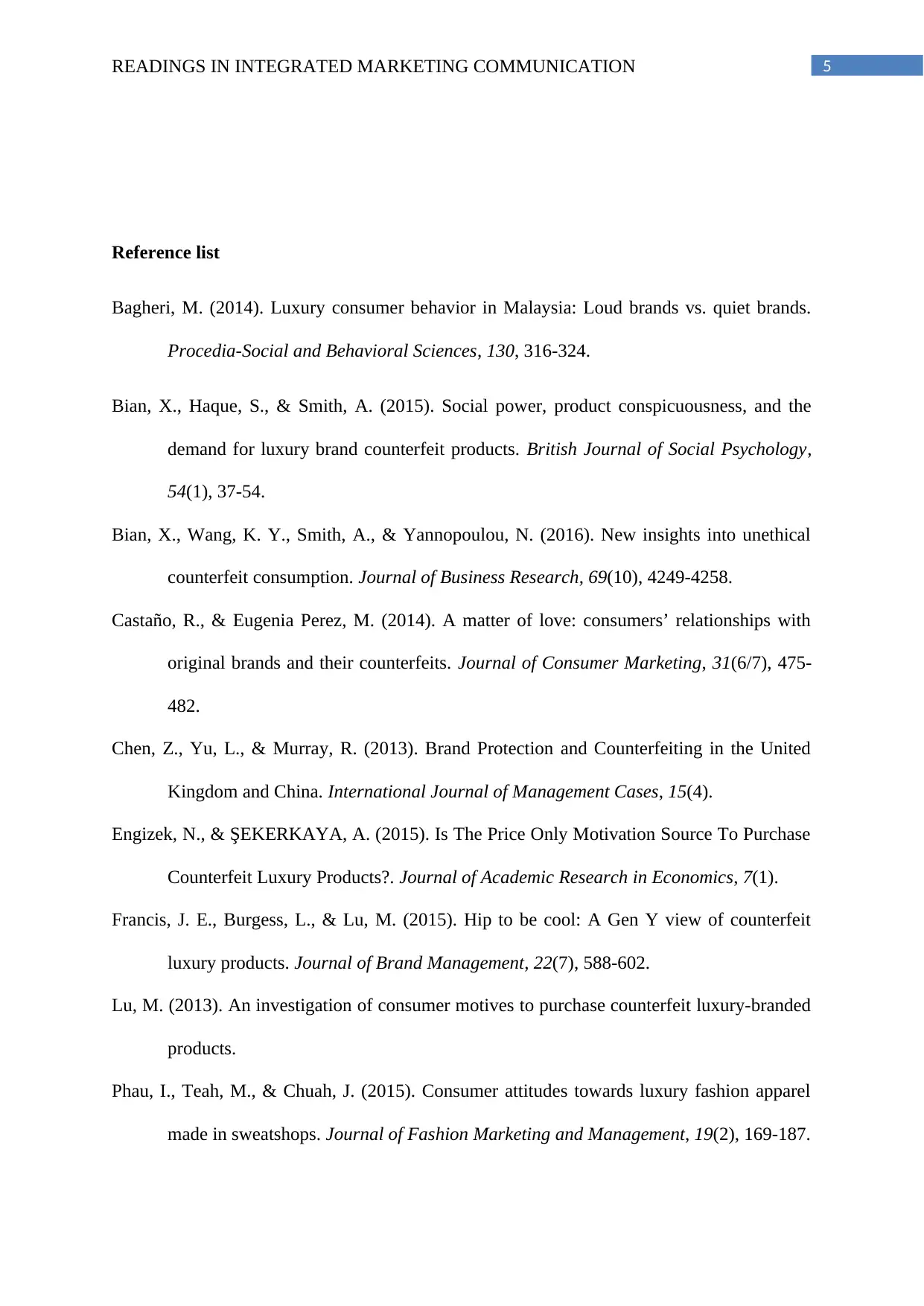
5READINGS IN INTEGRATED MARKETING COMMUNICATION
Reference list
Bagheri, M. (2014). Luxury consumer behavior in Malaysia: Loud brands vs. quiet brands.
Procedia-Social and Behavioral Sciences, 130, 316-324.
Bian, X., Haque, S., & Smith, A. (2015). Social power, product conspicuousness, and the
demand for luxury brand counterfeit products. British Journal of Social Psychology,
54(1), 37-54.
Bian, X., Wang, K. Y., Smith, A., & Yannopoulou, N. (2016). New insights into unethical
counterfeit consumption. Journal of Business Research, 69(10), 4249-4258.
Castaño, R., & Eugenia Perez, M. (2014). A matter of love: consumers’ relationships with
original brands and their counterfeits. Journal of Consumer Marketing, 31(6/7), 475-
482.
Chen, Z., Yu, L., & Murray, R. (2013). Brand Protection and Counterfeiting in the United
Kingdom and China. International Journal of Management Cases, 15(4).
Engizek, N., & ŞEKERKAYA, A. (2015). Is The Price Only Motivation Source To Purchase
Counterfeit Luxury Products?. Journal of Academic Research in Economics, 7(1).
Francis, J. E., Burgess, L., & Lu, M. (2015). Hip to be cool: A Gen Y view of counterfeit
luxury products. Journal of Brand Management, 22(7), 588-602.
Lu, M. (2013). An investigation of consumer motives to purchase counterfeit luxury-branded
products.
Phau, I., Teah, M., & Chuah, J. (2015). Consumer attitudes towards luxury fashion apparel
made in sweatshops. Journal of Fashion Marketing and Management, 19(2), 169-187.
Reference list
Bagheri, M. (2014). Luxury consumer behavior in Malaysia: Loud brands vs. quiet brands.
Procedia-Social and Behavioral Sciences, 130, 316-324.
Bian, X., Haque, S., & Smith, A. (2015). Social power, product conspicuousness, and the
demand for luxury brand counterfeit products. British Journal of Social Psychology,
54(1), 37-54.
Bian, X., Wang, K. Y., Smith, A., & Yannopoulou, N. (2016). New insights into unethical
counterfeit consumption. Journal of Business Research, 69(10), 4249-4258.
Castaño, R., & Eugenia Perez, M. (2014). A matter of love: consumers’ relationships with
original brands and their counterfeits. Journal of Consumer Marketing, 31(6/7), 475-
482.
Chen, Z., Yu, L., & Murray, R. (2013). Brand Protection and Counterfeiting in the United
Kingdom and China. International Journal of Management Cases, 15(4).
Engizek, N., & ŞEKERKAYA, A. (2015). Is The Price Only Motivation Source To Purchase
Counterfeit Luxury Products?. Journal of Academic Research in Economics, 7(1).
Francis, J. E., Burgess, L., & Lu, M. (2015). Hip to be cool: A Gen Y view of counterfeit
luxury products. Journal of Brand Management, 22(7), 588-602.
Lu, M. (2013). An investigation of consumer motives to purchase counterfeit luxury-branded
products.
Phau, I., Teah, M., & Chuah, J. (2015). Consumer attitudes towards luxury fashion apparel
made in sweatshops. Journal of Fashion Marketing and Management, 19(2), 169-187.
⊘ This is a preview!⊘
Do you want full access?
Subscribe today to unlock all pages.

Trusted by 1+ million students worldwide
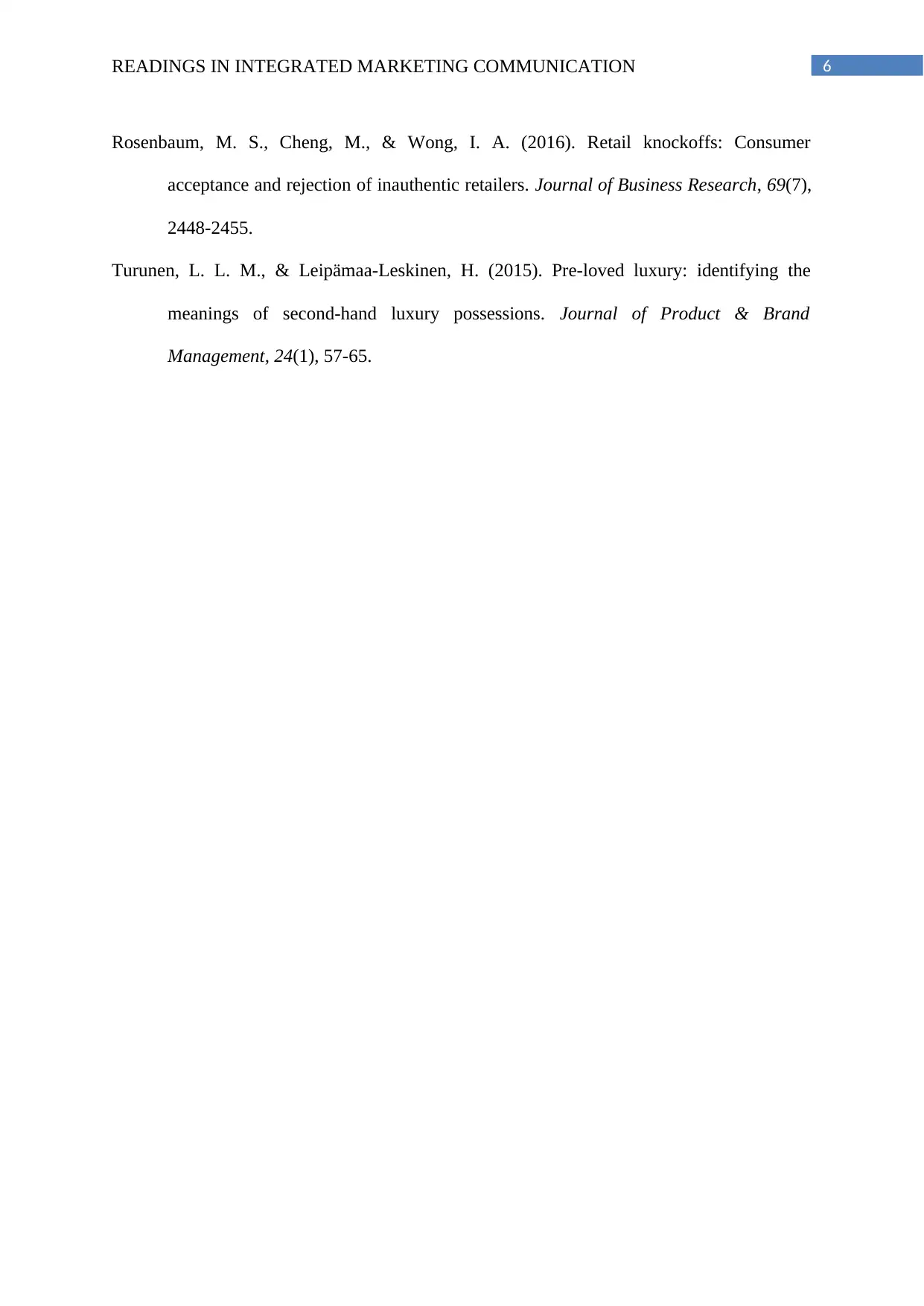
6READINGS IN INTEGRATED MARKETING COMMUNICATION
Rosenbaum, M. S., Cheng, M., & Wong, I. A. (2016). Retail knockoffs: Consumer
acceptance and rejection of inauthentic retailers. Journal of Business Research, 69(7),
2448-2455.
Turunen, L. L. M., & Leipämaa-Leskinen, H. (2015). Pre-loved luxury: identifying the
meanings of second-hand luxury possessions. Journal of Product & Brand
Management, 24(1), 57-65.
Rosenbaum, M. S., Cheng, M., & Wong, I. A. (2016). Retail knockoffs: Consumer
acceptance and rejection of inauthentic retailers. Journal of Business Research, 69(7),
2448-2455.
Turunen, L. L. M., & Leipämaa-Leskinen, H. (2015). Pre-loved luxury: identifying the
meanings of second-hand luxury possessions. Journal of Product & Brand
Management, 24(1), 57-65.
1 out of 7
Related Documents
Your All-in-One AI-Powered Toolkit for Academic Success.
+13062052269
info@desklib.com
Available 24*7 on WhatsApp / Email
![[object Object]](/_next/static/media/star-bottom.7253800d.svg)
Unlock your academic potential
Copyright © 2020–2025 A2Z Services. All Rights Reserved. Developed and managed by ZUCOL.




